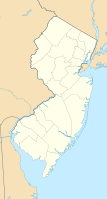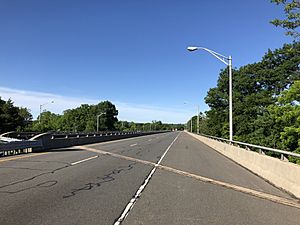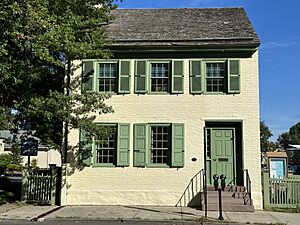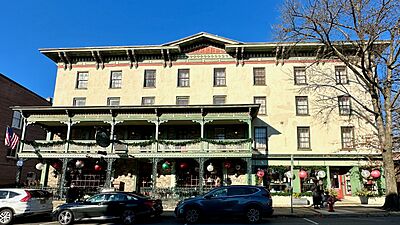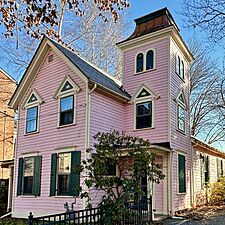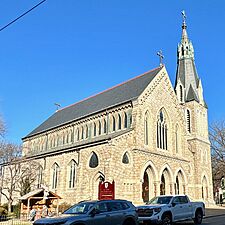Lambertville, New Jersey facts for kids
Quick facts for kids
Lambertville, New Jersey
|
||
|---|---|---|
|
City
|
||
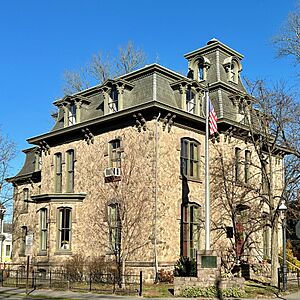
Lambertville City Hall
|
||
|
||
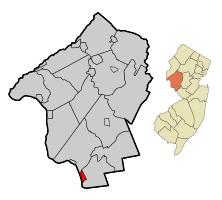
Location of Lambertville in Hunterdon County highlighted in red (left). Inset map: Location of Hunterdon County in New Jersey highlighted in orange (right).
|
||
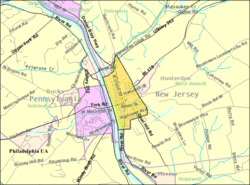
Census Bureau map of Lambertville, New Jersey
<mapframe text="Interactive map of Lambertville, New Jersey" zoom="8" width="250" height="250"> { "type": "ExternalData", "service": "geoshape", "ids": "Q1086436" } </mapframe> |
||
| Country | ||
| State | ||
| County | Hunterdon | |
| Incorporated | March 1, 1849 | |
| Named for | John Lambert | |
| Government | ||
| • Type | Faulkner Act (small municipality) | |
| • Body | City Council | |
| Area | ||
| • Total | 1.23 sq mi (3.17 km2) | |
| • Land | 1.08 sq mi (2.81 km2) | |
| • Water | 0.14 sq mi (0.36 km2) 11.46% | |
| Area rank | 482nd of 565 in state 21st of 26 in county |
|
| Elevation | 82 ft (25 m) | |
| Population
(2020)
|
||
| • Total | 4,139 | |
| • Estimate
(2023)
|
4,157 | |
| • Rank | 410th of 565 in state 11th of 26 in county |
|
| • Density | 3,817.3/sq mi (1,473.9/km2) | |
| • Density rank | 170th of 565 in state 2nd of 26 in county |
|
| Time zone | UTC−05:00 (Eastern (EST)) | |
| • Summer (DST) | UTC−04:00 (Eastern (EDT)) | |
| ZIP Code |
08530
|
|
| Area code(s) | 609 exchanges: 397, 773 | |
| FIPS code | 3401938610 | |
| GNIS feature ID | 0885271 | |
Lambertville is a small city in Hunterdon County, New Jersey. It is located on the banks of the Delaware River. In 2020, about 4,139 people lived there.
The city is directly across the river from New Hope, Pennsylvania. Long ago, in the 1700s, this area was known as Coryell's Ferry. It was named after Emanuel Coryell, who ran a ferry service across the river. This spot was an important stop on the old York Road, which connected New York City and Philadelphia.
In 1810, the community was named Lambertville. This honored John Lambert, a local resident. He had been a U.S. Senator and acting governor of New Jersey. He also helped open the first post office in town. Today, Lambertville is known as a friendly place for visitors, with a calm and welcoming feel.
Contents
History of Lambertville
Lambertville was first home to the Lenape (Delaware) Native Americans. Later, in 1732, Emanuel Coryell bought land here. He started a ferry service and opened a tavern for travelers. This made the area a busy stop between New York City and Philadelphia. During the American Revolutionary War, George Washington and his soldiers even camped at a local home built in 1744.
The Delaware River and the Delaware and Raritan Canal were very important for Lambertville's growth. The canal opened in 1834. It helped transport goods and people. Building the canal was hard work. About 4,000 Irish immigrants dug it by hand. Sadly, many workers died from a sickness called cholera in 1832.
Lambertville officially became a town on March 1, 1849. It became a city on March 26, 1872. In the 1800s, Lambertville was a factory town. Factories made many things, from clothes to rubber bands. This was because the town was near the canal and a railroad.
When cars became popular, the canal was used less. Factories started to close down. The railroad continued to be important for moving goods until the 1970s.
In the 1980s, Lambertville began to change. Artists and creative people moved in. Many old houses were fixed up. The city became a popular place for tourists. It now has many shops, art galleries, restaurants, and cozy B&Bs. You can also walk or bike along the canal path and enjoy the views of the river.
Geography and Climate
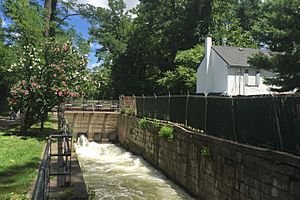
Lambertville covers about 1.23 square miles (3.17 square kilometers). Most of this is land, with a small part being water. The city shares borders with Delaware Township and West Amwell Township in New Jersey. It also borders New Hope and Solebury Township in Pennsylvania, across the Delaware River.
The Delaware and Raritan Canal flows through the western part of Lambertville. It runs next to the Delaware River. Parts of the Delaware and Raritan Canal State Park are in the city. These areas offer trails and bridges for people to enjoy.
Climate in Lambertville
Lambertville has a climate with hot and humid summers. Winters are generally cold. This type of weather is called a humid continental climate.
| Climate data for Lambertville, New Jersey (1991–2020 normals, extremes 1931–2002) | |||||||||||||
|---|---|---|---|---|---|---|---|---|---|---|---|---|---|
| Month | Jan | Feb | Mar | Apr | May | Jun | Jul | Aug | Sep | Oct | Nov | Dec | Year |
| Record high °F (°C) | 74 (23) |
75 (24) |
88 (31) |
95 (35) |
97 (36) |
100 (38) |
104 (40) |
101 (38) |
104 (40) |
95 (35) |
84 (29) |
75 (24) |
104 (40) |
| Mean daily maximum °F (°C) | 41.5 (5.3) |
44.2 (6.8) |
52.3 (11.3) |
63.8 (17.7) |
74.3 (23.5) |
83.4 (28.6) |
87.9 (31.1) |
86.6 (30.3) |
79.8 (26.6) |
68.1 (20.1) |
56.2 (13.4) |
46.3 (7.9) |
65.4 (18.6) |
| Daily mean °F (°C) | 30.2 (−1.0) |
33.0 (0.6) |
40.7 (4.8) |
51.6 (10.9) |
61.9 (16.6) |
70.5 (21.4) |
75.9 (24.4) |
73.6 (23.1) |
66.7 (19.3) |
54.2 (12.3) |
44.0 (6.7) |
35.4 (1.9) |
53.1 (11.7) |
| Mean daily minimum °F (°C) | 19.0 (−7.2) |
21.7 (−5.7) |
29.2 (−1.6) |
39.3 (4.1) |
49.4 (9.7) |
57.7 (14.3) |
63.8 (17.7) |
60.6 (15.9) |
53.7 (12.1) |
40.4 (4.7) |
31.9 (−0.1) |
24.5 (−4.2) |
40.9 (4.9) |
| Record low °F (°C) | −13 (−25) |
−18 (−28) |
0 (−18) |
13 (−11) |
25 (−4) |
38 (3) |
38 (3) |
34 (1) |
29 (−2) |
22 (−6) |
10 (−12) |
−5 (−21) |
−18 (−28) |
| Average precipitation inches (mm) | 3.65 (93) |
2.86 (73) |
4.33 (110) |
3.81 (97) |
4.32 (110) |
4.78 (121) |
5.11 (130) |
4.69 (119) |
4.44 (113) |
4.26 (108) |
3.50 (89) |
4.61 (117) |
50.36 (1,279) |
| Average snowfall inches (cm) | 5.8 (15) |
2.4 (6.1) |
2.6 (6.6) |
0.2 (0.51) |
0.0 (0.0) |
0.0 (0.0) |
0.0 (0.0) |
0.0 (0.0) |
0.0 (0.0) |
0.0 (0.0) |
0.2 (0.51) |
2.2 (5.6) |
13.4 (34) |
| Average precipitation days (≥ 0.01 in) | 10.4 | 8.8 | 10.9 | 11.3 | 11.9 | 10.6 | 10.0 | 9.4 | 8.3 | 9.5 | 8.7 | 10.7 | 120.5 |
| Average snowy days (≥ 0.1 in) | 1.8 | 1.2 | 0.9 | 0.0 | 0.0 | 0.0 | 0.0 | 0.0 | 0.0 | 0.0 | 0.1 | 0.8 | 4.8 |
| Source: NOAA | |||||||||||||
Population and People
| Historical population | |||
|---|---|---|---|
| Census | Pop. | %± | |
| 1850 | 1,417 | — | |
| 1860 | 2,699 | 90.5% | |
| 1870 | 3,842 | 42.3% | |
| 1880 | 4,183 | 8.9% | |
| 1890 | 4,142 | −1.0% | |
| 1900 | 4,637 | 12.0% | |
| 1910 | 4,657 | 0.4% | |
| 1920 | 4,660 | 0.1% | |
| 1930 | 4,518 | −3.0% | |
| 1940 | 4,447 | −1.6% | |
| 1950 | 4,477 | 0.7% | |
| 1960 | 4,269 | −4.6% | |
| 1970 | 4,359 | 2.1% | |
| 1980 | 4,044 | −7.2% | |
| 1990 | 3,927 | −2.9% | |
| 2000 | 3,868 | −1.5% | |
| 2010 | 3,906 | 1.0% | |
| 2020 | 4,139 | 6.0% | |
| 2023 (est.) | 4,157 | 6.4% | |
| Population sources: 1850–1920 1850–1870 1850 1870 1880–1890 1890–1910 1910–1930 1940–2000 2000 2010 2020 |
|||
In 2010, there were 3,906 people living in Lambertville. Most residents (about 91%) were White. About 1.95% were Black or African American, and 1.31% were Asian. About 9.75% of the population was Hispanic or Latino.
The average age of people in Lambertville in 2010 was 47.3 years old. About 13.7% of the population was under 18 years old.
Getting Around Lambertville

Lambertville has about 16.67 miles of roads. The main highway that goes through Lambertville is U.S. Route 202. Other important roads include Route 29 and Route 165.
There are no major interstate highways directly in Lambertville. However, some are nearby, like Interstate 78 and Interstate 295.
The New Hope-Lambertville Toll Supported Bridge connects Lambertville to New Hope, Pennsylvania. This bridge crosses the Delaware River and is free to use. The current bridge was built in 1904. Two earlier bridges on this spot were destroyed by floods.
Education in Lambertville
Students in Lambertville attend schools in the South Hunterdon Regional School District. This district serves students from pre-kindergarten through 12th grade. It includes students from Lambertville, Stockton, and West Amwell Township.
The district has three schools:
- South Hunterdon Regional Elementary School (PreK–4)
- South Hunterdon Regional Middle School (grades 5–8)
- South Hunterdon Regional High School (grades 9–12)
In 2013, voters decided to combine the school districts from these three towns into one regional district. This made the school system simpler for everyone.
Older students in Hunterdon County can also apply to the Hunterdon County Vocational School District. This district offers special career and technical programs.
Community Life
Every April, Lambertville celebrates the return of the shad fish. This fish was very important to the local fishing industry long ago. The festival, called ShadFest, started in 1981. It features local artists and helps support community groups. Lambertville is also known for its welcoming and open culture, similar to its neighbor, New Hope, Pennsylvania.
Dining Options
Lambertville is famous for its many places to eat. You can find all kinds of restaurants, from casual family spots to unique and fancy dining experiences.
Historic Places to Visit
Lambertville has several buildings and areas that are listed on the National Register of Historic Places. This means they are important historical sites.
Some of these historic places include:
- The James W. Marshall House, added in 1970.
- The Delaware and Raritan Canal, which is a historic district itself.
- The Lambertville House, a historic building.
- The Kalmia Club.
- The Lambertville City Hall, which was once a private home.
-
Bridge Tender's House for the Delaware and Raritan Canal
Famous People from Lambertville
Many interesting people have lived in or are connected to Lambertville:
- Bradley M. Campbell (born 1961), a former head of New Jersey's environmental protection department.
- James Gould Cozzens (1903–1978), a novelist who won a Pulitzer Prize.
- Elsie Driggs (1898–1992), a painter known for her precise style.
- Anne Elstner (1899–1981), an actress who played the main role in the radio show Stella Dallas.
- Anne Garefino (born 1959), a co-producer for the TV show South Park and the musical The Book of Mormon.
- Harry Haenigsen (1900–1990), a cartoonist famous for his comic strip Penny.
- George Holcombe (1786–1828), who served in the U.S. House of Representatives.
- William Holcombe (1804–1870), the first Lieutenant Governor of Minnesota.
- John Lambert (1746–1823), a U.S. Senator and the person Lambertville is named after.
- Samuel Lilly (1816–1880), who was the first mayor of Lambertville.
- James W. Marshall (1810–1885), famous for discovering gold in California in 1848.
- James McBride (born 1957), a well-known author and musician.
- Scott Metzger (born 1977), a guitarist who plays in popular bands.
- Bror Julius Olsson Nordfeldt (1878–1955), a Swedish-born American artist.
- Erik Peterson (born 1966), a member of the New Jersey General Assembly.
- Gerald Stern (1925-2022), a poet who was the Poet Laureate of New Jersey.
- Kyle Tress (born 1981), an Olympic athlete in the sport of skeleton.
- Gene Ween (born 1970), a founding member of the band Ween.
See also
 In Spanish: Lambertville (Nueva Jersey) para niños
In Spanish: Lambertville (Nueva Jersey) para niños




